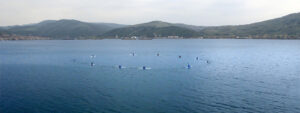It is a pleasure and privilege to launch the Journal of Visual Culture‘s online magazine with this dossier on the imbrications of the extractive and the visual.
Industries of extraction proper (e.g., mining and monocropping) have long relied on imaging practices in perceiving and portraying places and communities as no more than extractable energy resources while also engendering new visualities in the process. The current historical juncture has unprecedentedly complexified this co-constitutive relationship between imaging and extracting. On the one hand, issues underpinned by extraction such as climate change and environmental disasters are now more visible than ever. On the other hand, characteristically visual fields such as art and media have themselves become a foremost arena for industrial-scale extractive methods and practices, not to mention the acceleration of industries of extraction proper and visuality’s remaining central to them.
The dossier responds to this historical juncture. It asks, how are artistic and mediatized images (including but not limited to those involved in industries of extraction proper) implicated in the increasingly diversified and expansive ways in which industrial-scale extractive methods and practices operate? To what extent do the ways images are produced, circulated, theorized, and politicized mirror or challenge extractive methods and practices?
The dossier consists of seven essays. Three are published on the occasion of this launch (by Kehar, Mendes, and Badcock) while the rest will appear on this website periodically over the next six months. The dossier aims to transcend both disciplinary boundaries and regionalisms. The authors draw from the fields of art history, cultural geography, literary criticism, architectural theory, curatorial and artistic practice, political science, and media studies. Their essays engage with and are committed to a diverse set of contexts ranging from Southeast Asia, West Africa, and the Americas, which have long figured prominently in relevant debates, to the Balkans and Eastern Europe, which have yet to receive such prominence.[1]
The questions that orientate the dossier also inform its titular reference to extractivism rather than extraction. The operative concept of extractivism looms large in recent critical debates on what has been termed “the Anthropocene”—the idea that humanity is now the foremost factor determining the Earth’s catastrophe-laden workings and physical makeup. Against the term’s pointing to humanity as both culprit and victim, critical debates spawned by it have now established that “the Anthropocene,” whether in terms of causes or effects, is in fact anything but evenly anthropic, and that this unevenness is due to the racialized and racializing character of global capitalism whose main mode of operation is extraction on an industrial scale.[2]
As such, extraction has involved not only physical interventions but also symbolic and epistemic facets throughout the intertwined histories of nation-statism and colonialism, which have instituted the still-dominant paradigm of racial capitalism. Extractive methods and practices have hinged on and generated symbolisms and epistemes that reduce the worth of those whose wealth and labour are extracted to the quantifiably measurable and marketable value of an extractable resource. Coal-driven British colonialism in the early 19th century, a milestone in the history of the fossil economy, attracted investors through racialized representations of colonized lands and peoples as an extractable resource, thereby “affix[ing] … race to space.”[3] Slavery-based plantation economy, which drove colonialism in the Americas by extracting land and labour from racialized peoples, hinged on a “grim calculus of cheap labour-power and acceptable deaths” that turned the continent into one of “capital’s laboratories of modernity” and “proletarianization.”[4] These practices constituted an epistemic and symbolic structure through which colonialism quantified and marketized peoples and geographies as “things.”[5] As extractivism continues to operate today beyond colonies proper and even across postcolonial geographies, it remains structured by the same valuation logic based on quantifiability and marketability.[6] The same historical process has also seen the visual become increasingly central to the knowledge systems and symbolisms at work in racial capitalism. For Nicholas Mirzoeff, it is nothing but the organized political violence of colonialism and imperialism that, throughout the history of modernity, has structured the entire field of “visuality” in line with extractivism.[7]
There is now a sizeable literature which discusses the recent and ongoing repercussions of the visuality-extractivism nexus and which is illuminating thanks not only to its critical analytical prowess but also to its insistence on imagining the visual otherwise especially by spotlighting practices straddling the worlds of art and activism. Examples include “practices of buen vivir (sustainable living) and grassroots resistance” against “hydroelectric megaprojects” reliant on portrayal of rivers as extractable resources, those of “autonomous image production” that obstruct conventional landscape photography’s “enclosure view of the commons,” or those that use visual tropes valued by the colonized and conducive to “multi-species ecojustice.”[8] If these examples turn on making places and communities visible in ways inconducive to extraction, other instances in relevant scholarship problematize visibility itself. They underline that “what’s visible, and to whom, tends to split the global population along the fault lines suggested by extractivism itself” and “recognize the right to refuse visibility when it inadvertently reinforces power inequalities and neocolonial logics in the era of sensationalist, commercialized media and surveillance capitalism.”[9] Macarena Gómez-Barris’ work on Latin America features such refusal of visibility as generative of “submerged perspectives” that are organized below the modern colonial order” and “undetected by the regime of state power.”[10] Many of these debates therefore retain a focus on visibility even as they attend to its unequal distribution, refusal and contrarian variations, while also tracing the imbrications of the visual and the extractive in sites of extraction proper (e.g., mines, dams, plantations, logging sites, etc.) even as they operationalize a concept of extractivism much more expansive than the latter.
The dossier follows in the footsteps of this growing literature critical of the visuality-extractivism nexus while also expanding on its specific empirical focus on sites of resource extraction proper and the analytical one on visibility. The intention in so doing is to account for the ways extractive methods and practices have diversified and expanded to realms beyond industries of extraction proper, including the characteristically visual fields of art and media. Such fields now bear the imprint of extractivism due not only to the relatively widely debated problem of funding that comes from companies engaged in resource extraction but also to the ways in which material (whether in a physical sense or in terms of subject matter, or both) is sourced, developed into final works, circulated, and valuated as useful or impactful.[11] Attending to the latter means that theorizations of the visual merit as much critical reconsideration as visual production itself, provided that they operate within a similarly corporatized and marketized institutional paradigm of research and scholarship.[12]
This paradigm doubtless also implicates this dossier. While all contributors, including myself, are early career researchers most of whom are precariously employed, we are not immune from extractivism whether due to the North Atlantic institutions that employ us, the metrics-based methods used in valuating our work, or the privately owned platforms where we are expected to disseminate the knowledge we produce. To draw attention to this implication is not to advocate cynicism or self-reflexivity as an end in itself but rather to refrain from becoming, if unwillingly and indirectly, a vector for the very extractive methods and practices we critique—from being governed by them even as we call them into crisis.[13] One way we aim to do so is by disavowing solutionism or dispensing with the assumption that solutions to extractivism can derive from discrete visual practices (or theories thereof) produced by professionals inhabiting an epistemic and cultural production paradigm structured by the same geographical and racial hierarchies characterizing extractivism. Disavowing solutionism avoids both distracting from the collective political work of organizing and mobilizing that is in fact necessary to dismantle extractivism and appropriating this work’s progressively transformative energies even as we hope our dossier may offer pointers as to where such work could intervene or intensify.[14]
Notes
[1] This dossier originated in an event I organized at LSE in April 2021. Titled “Violence, Aesthetics, Anthropocenes: Colonialism, Racism, Extractivism,” the event comprised an evening panel discussion followed by a full day of presentations and responses to them from the previous evening’s panelists. I would like to thank the London Arts and Humanities Partnership which funded the event and the following presenters whose work is not featured in this dossier: Rojda Tuğrul, K. Yoland, Alice Owen & Siti Maimunah, Kate Lewis Hood, and George Ygarza. Alongside Manca Bajec who served as a discussant at the event and whose work as Managing Editor of the Journal of Visual Culture has been invaluable in making this dossier possible, I wish to thank the other discussants whose work is not represented here: Helene Kazan, Thandi Loewenson, and Ignacio Acosta. I express my gratitude to Sarah Gerwens whose logistical assistance during the event was instrumental in making it a collegial as well as stimulating occasion. Finally, I am grateful to the authors who have generously contributed to this dossier: Anousheh Kehar, Margarida Mendes, Jacob Badcock, Lara Fresko Madra, Distributed Cognition Cooperative (Sasha Shestakova & Anna Engelhardt), Ishita Sharma, and Christine Okoth who was a discussant at the April 2021 event and whose epilogue will conclude this dossier.
[2] On the point about causes, see Andrew Baldwin and Bruce Erickson (2020) Introduction: Whiteness, coloniality, and the Anthropocene, Environment and Planning D: Society and Space 38(1): 3–11; Joshua R. Eichen (2020) Cheapness and (labor-)power: The role of early modern Brazilian sugar plantations in the racializing Capitalocene, Environment and Planning D: Society and Space 38(1): 35–52; Timothy W. Luke (2020) Tracing race, ethnicity, and civilization in the Anthropocene, Environment and Planning D: Society and Space 38(1): 129–46. On the point about effects, see Lindsey Dillon and Julie Sze (2016) Police power and particulate matters: Environmental justice and the spatialities of in/securities in US cities, English Language Notes 54(2): 13–23; Kathryn Yusoff (2018) A Billion Black Anthropocenes or None (Minneapolis, MN: Minnesota University Press); Pavithra Vasudevan (2021) An intimate inventory of race and waste, Antipode 53(3): 770–90.
[3] On extractivist representations in early 19th-century British colonialism, see Andreas Malm (2017) The Progress of This Storm: Nature and Society in a Warming World (London: Verso), 19–20. On the spatialization of race, see Uli Linke (2014) Racializing cities, naturalizing space: The seductive appeal of iconicities of dispossession, Antipode 46(5): 1225. On more recent examples of visuality’s centrality to extractivism, see Sylvain Guyot (2011) The eco-frontier paradigm: Rethinking the links between space, nature and politics, Geopolitics 16(3): 682; Andrew Barry (2013) Material Politics: Disputes along the Pipeline (Oxford: Wiley-Blackwell), 116–36; Macarena Gómez-Barris (2017) The Extractive Zone: Social Ecologies and Decolonial Perspectives (Durham, NC: Duke University Press), 5–7; John Childs (2020) Extraction in four dimensions: Time, space, and the emerging geo(-)politics of deep-sea mining, Geopolitics 25(1): 189–213; Bruce Erickson (2020) Anthropocene futures: Linking colonialism and environmentalism in an age of crisis, Environment and Planning D: Society and Space 38(1): 113.
[4] Eichen, Cheapness and (labor-)power, 35.
[5] Baldwin and Erickson, Introduction, 6–7; Jonathan Rosa and Vanessa Díaz (2020) Raciontologies: Rethinking anthropological accounts of institutional racism and enactments of white supremacy in the United States, American Anthropologist 122(1): 4.
[6] On extractivism’s operations beyond colonies proper, see Childs, Extraction in four dimensions, 201–2. On its operations in postcolonial geographies, see Gómez-Barris, The Extractive Zone; Thea Riofrancos (2017) Extractivismo unearthed: A genealogy of a radical discourse, Cultural Studies 31(2–3): 277–306; Gisela V. Rodriguez Fernandez (2020) Neo-extractivism, the Bolivian state, and Indigenous peasant women’s struggles for water in the Altiplano, Human Geography 13(1): 27–39. On its quantifiability-based logics of valuation, see Fabiana Li (2013) Contesting equivalences: Controversies over water and mining in Chile and Peru, in The Social Life of Water, ed. John Richard Wagner (New York: Berghahn), 18–35; Eray Çaylı (2021) The aesthetics of extractivism: Violence, ecology, and sensibility in Turkey’s Kurdistan, Antipode 53(5): 1377-1399.
[7] Nicholas Mirzoeff (2011) The Right to Look: A Counterhistory of Visuality (Durham, NC: Duke University Press).
[8] On making visible “buen vivir” and “grassroots resistance,” see Lisa Blackmore (2020) Turbulent River Times: Art & Hydropower in Latin America’s Extractive Zones, in Lisa Blackmore and Liliana Gómez (eds.) Liquid Ecologies in Latin American and Caribbean Art (New York, NY: Routledge), 13–34. On “autonomous image production,” see Macarena Gómez-Barris (2018) How to block the extractive view, GLQ: A Journal of Lesbian and Gay Studies 24(4): 527-532. On the point about “multi-species ecojustice,” see Philippa Lovatt (2020) (Im)material histories and aesthetics of extractivism in Vietnamese artists’ moving image, Southeast of Now: Directions in Contemporary and Modern Art in Asia 4(1): 221–236.
[9] See, respectively: Justin Parks (2021) The poetics of extractivism and the politics of visibility, Textual Practice 35(3): 353; T. J. Demos, Emily Eliza Scott and Subhankar Banerjee (2021) Introduction, in TJ Demos, Emily Eliza Scott and Subhankar Banerjee (eds.) The Routledge Companion to Contemporary Art, Visual Culture, and Climate Change (New York, NY: Routledge), 8.
[10] Macarena Gómez-Barris (2021) Submerged perspectives: The arts of land and water defense, Globalizations 18(6): 854-863.
[11] On artistic and/or mediatized extractivism, see Paula Serafini (2020) Cultural production beyond extraction? A first approach to extractivism and the cultural and creative industries in Argentina, in Kate Oakley and Mark Banks (eds.) Cultural Industries and the Environmental Crisis: New Approaches for Policy (Cham: Springer), 51-63; Eray Çaylı (2021) Contemporary art and the geopolitics of extractivism in Turkey’s Kurdistan, Transactions of the Institute of British Geographers 46(4): 929– 943; Andrew deWaard (2020) Financialized Hollywood: Institutional investment, venture capital, and private equity in the film and television industry, JCMS: Journal of Cinema and Media Studies 59(4): 54–84.
[12] On extractivism as a force that shapes today’s predominant paradigm of scholarly research in the social sciences and humanities, see Laura Junka-Aikio and Catalina Cortes-Severino (2017) Cultural studies of extraction, Cultural Studies 31(2–3): 175–184; Lisa Tilley (2017) Resisting piratic method by doing research otherwise, Sociology 51(1): 27–42; Ramón Grosfoguel (2019) Epistemic extractivism: A dialogue with Alberto Acosta, Leanne Betasamosake Simpson, and Silvia Rivera Cusicanqui, in Boaventura de Sousa Santos and Maria Paula Meneses (eds.) Knowledges Born in the Struggle: Constructing the Epistemologies of the Global South (New York: Routledge), 203-218; Melany Cruz and Darcy Luke (2020) Methodology and academic extractivism: The neo-colonialism of the British university, Third World Thematics: A TWQ Journal 5(1-2): 154–170.
[13] On critique as not only calling a given situation into crisis but also refusal to be governed by that which is called into crisis, see Jane Rendell (2018) Configuring critique (or ‘the art of not being governed quite so much’), in Chris Brisbin and Myra Thiessen (eds.) The Routledge Companion to Criticality in Art, Architecture, and Design (London: Routledge), 128–46.
[14] On collective political work being an imperative for imaging practices to engender progressive social change, see Andrew Herscher (2011) From target to witness: Architecture, satellite surveillance, human rights, in Bechir Kenzari (ed.) Architecture and Violence: Reception and Reproduction (Barcelona: Actar), 123–44; Andrew Herscher (2014) Surveillant witnessing: Satellite imagery and the visual politics of human rights, Public Culture 26(3): 469–500; T. J. Demos (2016) Decolonizing Nature: Contemporary Art and the Politics of Ecology (Berlin: Sternberg Press), 264–66.
Image
Forest of eucalyptus trees planted to absorb contaminated water from Los Pelambres mine, Los Vilos commune, Chile, 2012 (courtesy of the artist Ignacio Acosta).
About the author
Eray Çaylı studies the spatial and visual politics of violence and disasters in ways that speak to the fields of anthropology, geography, architecture, and art. Alongside numerous journal articles on the subject, his major publications include the monographs Victims of Commemoration: The Architecture and Violence of Confronting the Past in Turkey and Climate Aesthetics: Essays on Anthropocene Art and Architecture (in Turkish), and the anthology Architectures of Emergency in Turkey: Heritage, Displacement and Catastrophe which he co-edited. He is Professor of Human Geography at University of Hamburg, and a member of the Journal of Visual Culture‘s editorial collective.
Cite as
Eray Çaylı. “Extractivism: Introduction to the dossier,” edited by Eray Çaylı, JVC Magazine, 10 September 2022, https://www.journalofvisualculture.org/extractivism/





